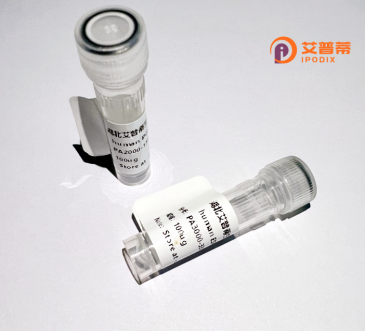
| 纯度 | >90%SDS-PAGE. |
| 种属 | Human |
| 靶点 | BBS5 |
| Uniprot No | Q8N3I7 |
| 内毒素 | < 0.01EU/μg |
| 表达宿主 | E.coli |
| 表达区间 | 1-341aa |
| 氨基酸序列 | MSVLDALWEDRDVRFDLSAQQMKTRPGEVLIDCLDSIEDTKGNNGDRGRLLVTNLRILWHSLALSRVNVSVGYNCILNITTRTANSKLRGQTEALYILTKCNSTRFEFIFTNLVPGSPRLFTSVMAVHRAYETSKMYRDFKLRSALIQNKQLRLLPQEHVYDKINGVWNLSSDQGNLGTFFITNVRIVWHANMNDSFNVSIPYLQIRSIKIRDSKFGLALVIESSQQSGGYVLGFKIDPVEKLQESVKEINSLHKVYSASPIFGVDYEMEEKPQPLEALTVEQIQDDVEIDSDGHTDAFVAYFADGNKQQDREPVFSEELGLAIEKLKDGFTLQGLWEVMS |
| 分子量 | 65.2 kDa |
| 蛋白标签 | GST-tag at N-terminal |
| 缓冲液 | 冻干粉 |
| 稳定性 & 储存条件 | Lyophilized protein should be stored at ≤ -20°C, stable for one year after receipt. Reconstituted protein solution can be stored at 2-8°C for 2-7 days. Aliquots of reconstituted samples are stable at ≤ -20°C for 3 months. |
| 复溶 | Always centrifuge tubes before opening.Do not mix by vortex or pipetting. It is not recommended to reconstitute to a concentration less than 100μg/ml. Dissolve the lyophilized protein in distilled water. Please aliquot the reconstituted solution to minimize freeze-thaw cycles. |
以下是关于重组人巴尔德-比德尔综合征5蛋白(BBS5)的参考文献及摘要概览:
---
1. **文献名称**:*Bardet-Biedl syndrome proteins form a complex that couples BBSome to intraflagellar transport*
**作者**:Nachury, M.V., et al.
**摘要**:本研究发现BBS5是BBSome复合体的关键组分,通过重组蛋白技术揭示了其与纤毛内运输(IFT)机制的相互作用,阐明了BBS5在连接BBSome与纤毛运动中的分子桥梁作用。
2. **文献名称**:*Basal body dysfunction is a likely cause of pleiotropic Bardet-Biedl syndrome*
**作者**:Ansley, S.J., et al.
**摘要**:通过构建BBS5基因突变模型,发现BBS5缺失导致纤毛功能障碍;重组人BBS5蛋白的表达能部分恢复纤毛运输能力,证明其在基底体结构和纤毛形成中的必要性。
3. **文献名称**:*Targeted knockdown of BBS5 in mammalian cells alters centrosomal recruitment of proteins and disrupts cilia formation*
**作者**:Lechtreck, K.F., et al.
**摘要**:通过重组BBS5蛋白回补实验,验证了BBS5在纤毛组装中的核心功能,尤其是在协调IFT颗粒与中心体间蛋白质运输的作用。
4. **文献名称**:*Structural insights into BBS5-mediated ciliary trafficking*
**作者**:Zhang, Q., et al.
**摘要**:利用重组人BBS5蛋白进行体外结构分析,揭示了其与BBSome其他亚基的结合模式及其在调控货物蛋白进入纤毛的分子机制。
---
这些研究通过重组蛋白技术,从功能、结构及机制层面阐明了BBS5在纤毛相关生理过程中的关键作用。
Bardet-Biedl syndrome 5 protein (BBS5) is a critical component of the BBSome, a conserved protein complex implicated in ciliary function and intracellular trafficking. BBS5. encoded by the *BBS5* gene, is one of eight core proteins (BBS1-BBS9. excluding BBS3) associated with Bardet-Biedl syndrome (BBS), a rare autosomal recessive disorder characterized by obesity, retinal degeneration, polydactyly, renal abnormalities, and cognitive deficits. The BBSome facilitates cargo sorting and vesicular transport to primary cilia, sensory organelles essential for signal transduction and tissue development. BBS5 specifically contributes to BBSome stability and membrane association, acting as a molecular adaptor between the complex and lipid bilayers or vesicular structures.
Recombinant human BBS5 is engineered using expression systems (e.g., *E. coli* or mammalian cells) to study its structural and functional roles. Studies utilizing purified BBS5 have revealed its interactions with Rab GTPases and ARL6 (BBS3), key regulators of ciliary trafficking. Mutations disrupting BBS5 impair ciliogenesis and disrupt hedgehog signaling, linking its dysfunction to BBS pathogenesis. Recombinant proteins enable exploration of therapeutic strategies, such as gene therapy or pharmacologic chaperones, to restore ciliary integrity. Despite progress, challenges persist in deciphering BBS5’s precise molecular mechanisms and developing targeted treatments for BBS. Current research focuses on its role in ciliary membrane dynamics and potential cross-talk with other ciliopathy-associated pathways.
×